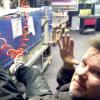In your opinion are tablesaw injuries more likely to occur. With someone with say many years of experience. Or someone who has maybe a year experience. Is it due to everyday use and odds of injuries goes up. Or for the Person lacks the experience. Just a thought.






 Reply With Quote
Reply With Quote






 . Sorry to be snide but, the whole "your tablesaw attacked me" thing really lights me up.
. Sorry to be snide but, the whole "your tablesaw attacked me" thing really lights me up.


